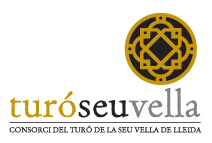From the late 12th century, Lleida played an important role in the pilgrimage roads to Compostela. Both from the Pyrenees and from the coast, all Catalan paths converged, thus making the city an important stage in this important route, while being a meeting point as well as a place for exchange, relief and rooming for travellers and pilgrims.
In the Seu Vella, a chapel was dedicated to him very early on, near the high altar, where three capitals of excellent sculpture narrate the death sentence, decapitation, and transfer of his body to Galicia and the discovery of his tomb. The image of James the Greater would also be present at the imposing gate of the Apostles, where he was dressed as a pilgrim, with his hat and characteristic shell, bag and walking stick.
These shells were also seen in the paintings that decorated the walls of the Pia Almoina, the almshouse located in the Canonical building where scenes were represented with pilgrims eating and drinking around a table. The paintings, now exhibited at the Museu de Lleida: diocesà i comarcal, are another example of the reception of those who travelled the route to Santiago. Finally, the Peu del Romeu Chapel, at the confluence of the streets Cavallers and Major, call to mind the exact spot where, according to legend, St. James stepped on a thorn that he removed with the light from some lanterns that were lowered to him by an angel from heaven.





